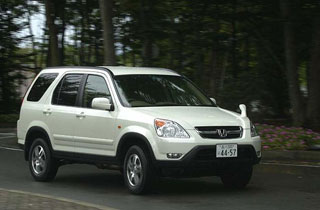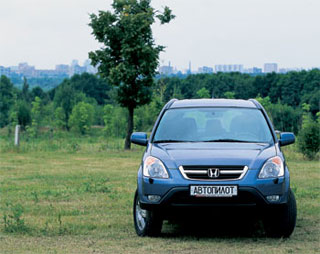Test drive Honda CR-V 2002-2004 SUV
Two approaches
 Between themselves, RAV-4 and CR-V are approximately as a compact city hatchback and a spacious family station wagon. Or even as a hatchback and a compact minivan
Between themselves, RAV-4 and CR-V are approximately as a compact city hatchback and a spacious family station wagon. Or even as a hatchback and a compact minivan Who in 1995 could have assumed that by introducing the public something passenger with the exterior of an SUV and the interior of a compact minivan, Honda opened a gold mine? At first, it came to the point that the CR-V, originally intended mainly for the States and Japan, the most natural gray sales arose in Europe! In accordance with the wishes of Europeans, it was urgent to make a modification with a mechanical gearbox (1997), and in order to satisfy demand over time to place production at the European plant in Swindon (Great Britain).
 From a successful idea, Honda managed to remove a considerable amount of cream for many CR-V buyers was much more attractive to most of the then SUVs, which, in fact, represented SUVs with reduced road clearance. But still, the feast alone could not be long: the pie was too big and appetizing so that the neighbors refused to participate in the division. Many urgently took up the development of direct analogues in the image and likeness, Toyota did not begin to do this: its RAV-4 was inferior to CR-V in capacity and functionality, it was close in meaning. And in design, like Honda, I looked more like a passenger car than an SUV. And the heir, which appeared in 2000 and updated in the past, became an even more serious opponent for the former CR-V and for a new, sample of 2002.
From a successful idea, Honda managed to remove a considerable amount of cream for many CR-V buyers was much more attractive to most of the then SUVs, which, in fact, represented SUVs with reduced road clearance. But still, the feast alone could not be long: the pie was too big and appetizing so that the neighbors refused to participate in the division. Many urgently took up the development of direct analogues in the image and likeness, Toyota did not begin to do this: its RAV-4 was inferior to CR-V in capacity and functionality, it was close in meaning. And in design, like Honda, I looked more like a passenger car than an SUV. And the heir, which appeared in 2000 and updated in the past, became an even more serious opponent for the former CR-V and for a new, sample of 2002.  We took on the test a five-door post-bacillus RAV-4, equipped with everything that you can imagine in a similar car, including the upholstery of seats with skin, six airbags and a system of dynamic stabilization. The company was made by CR-V in the richest configuration, also with leather upholstery, but only with four airbags and without a stabilization system. If you calculate what such a difference is usually the case, then you can only wonder that RAV-4 costs ... $ 200 is cheaper!
We took on the test a five-door post-bacillus RAV-4, equipped with everything that you can imagine in a similar car, including the upholstery of seats with skin, six airbags and a system of dynamic stabilization. The company was made by CR-V in the richest configuration, also with leather upholstery, but only with four airbags and without a stabilization system. If you calculate what such a difference is usually the case, then you can only wonder that RAV-4 costs ... $ 200 is cheaper!  Dimensional question
Dimensional question The first CR-V was a recognizable car, but somehow in itself. The second received some details hinting at the Honda Pilot (design of the front line) and Acura MD-X (body racks) in North America. Nevertheless, with branded recognition of special expressiveness, the appearance is not observed here. What can not be said about the opponent, although it does not look like other Toyota brands. Its almost living physiognomy is performed by a hassle-decent concentration, which is why the short and squat Rav resembles a bulldog on a walk.
Looking at cars outside, it is easy to guess that the RAV-4 is noticeably more closely inside. And the architecture of its interior, and primarily an inflated front panel, does not at all contribute to the visual expansion of space. CR-V is the direct opposite: not only is the interior spacious in itself, this sensation is still enhanced by the dashboard resembling a rack from a modern studio apartment, decorated in the style of techno.
Nevertheless, I would like to understand why Japanese automakers, selling cars in the United States and Europe for decades, continue to pretend that there are no drivers higher than 180 cm tall. However, in the RAV-4 high is uncomfortable both in front and from behind, which is clear the length of the cabin. It is not clear why Honda, providing passengers of the rear seat for almost the limousine space for the legs, so limited the range of adjustment of the front seats.
But it is completely easy to make an unambiguous conclusion about which of these cars will almost certainly be a means of individual movement around the city, and which the family will choose for close and long -distance travel. CR-V is not only spacious, but also noticeably larger than the trunk. And more opportunities for its increase by moving forward the rear seat, the rear passengers reserve are quite large. And the fact that the rear seat here is folded with asymmetric parts is also a big plus, not to mention the hinged armrest built in the back. And for sure everyone will like a convenient folding table, which plays the role of trunk floor. And most likely, the niche trimmed with plastic will not be superfluous, which is hidden under this floor. And of course, passengers will appreciate the flat, as in Minivan, the floor of the salon without any hint of the central tunnel. And also the fact that the table between the front seats can be lowered in order to move along the cabin in the weather without going outside.
 Surprises time
Surprises time One cannot but admit: a sports instrument shield and a magnificent steering wheel RAV-4 create a very definite mood I want to go actively. And if you follow this desire, then it will still intensify along the way. Not because the dynamics is hurricane, but because the sound of the motor starts when accelerating it is heard in the cabin too well, and if you don’t have a particularly sports mood, perhaps, it may be bored over time.
In general, the sounds in the RAV-4 salon, which requires a separate study. Say, when driving along a dirt road, the rustle of sand and small pebbles along the wheels of wheels is well heard. But only the rear wheels. On an uneven road, another rustle of interior panels is heard. And when accelerating at the top, when the tachometer arrow reaches 5600, under the instrument panel, a rather loud itching sound occurs some kind of detail falls into a resonance. Do not consider a pick -up: for an expensive car of a well -known brand with a mileage of only 1,500 km, all this seems, to put it mildly, strange. Maybe just somewhere the bolt unscrewed?
In this sense, Honda will not give you any surprises: the interior is monolithly silent, noise insulation at the height, and the thoroughbred voice of the motor, coming from somewhere during acceleration, does not annoy under any circumstances.
However, back to dynamics. It is unlikely that anyone can disappoint modern engines equipped with intellectual systems for regulating phases and the height of valve lifting. Confident craving at low speeds, but even more confident rise from 3000-3500 rpm, and then uniform acceleration to the red zone. Nevertheless, each car has its own character, determined, to a greater extent, automatic transmission.
 Drestyling RAV-4 was periodically scolded for the slowness of the machine gun now difficult to blame it for this: sometimes it is even too frantic, in a hurry to offer a reduced gear when, in general, you do not expect it. However, such a inconsistency is more likely an exception than the rule, the machine gun is really good.
Drestyling RAV-4 was periodically scolded for the slowness of the machine gun now difficult to blame it for this: sometimes it is even too frantic, in a hurry to offer a reduced gear when, in general, you do not expect it. However, such a inconsistency is more likely an exception than the rule, the machine gun is really good. But the automatic transmission CR-V demonstrates truly exquisite manners. Switching is timely, fast, without delay, but at the same time the mild not the slightest hint of jerks. And one more thing: the machine not only allows you to effectively slow down the engine in compulsory modes, but it itself reduces the transmission on long descents in time, holding a constant speed like a cruise control. The rationality and accuracy of his behavior simply conquer!
Noble manners
If you thought that the magnificent (not a pity to repeat!) The steering wheel RAV-4 is a testimony of good controllability, then you were not mistaken! Of course, the sensitivity of the steering here cannot be called sports, nevertheless, the car was made for the average consumer. But the reactions of the car are fast, very accurate, and the rolls are very, very small. And with reactive action, everything is great! A very passenger, very pleasant car, you can even say gambling.
 A higher and larger CR-V rival is also not inferior to the passenger and also very correct, just less gambling: the rolls are a little more, the reaction is slightly slower. And it is a little so small that making a choice on its basis is simply unreasonable. Moreover, excellent stability at high speeds is certainly the general advantage of both.
A higher and larger CR-V rival is also not inferior to the passenger and also very correct, just less gambling: the rolls are a little more, the reaction is slightly slower. And it is a little so small that making a choice on its basis is simply unreasonable. Moreover, excellent stability at high speeds is certainly the general advantage of both. But in critical regimes you may be awaiting surprises. However, RAV-4 behaves quite unambiguously. It is only necessary to be prepared for the fact that in Toyota traditions, the stabilization system gives you such a head start for independent actions that in other cases you manage to independently catch the car even before its intervention.
CR-V requires a more reverent attitude: its full-wheel drive system connects the rear wheels only with a noticeable slipping of the front, so that the nature of the reactions to a change in fuel supply can change directly during an unplanned sliding.
And since we are talking about cars for outdoor activities, we will touch the topic of cross -country a little.
It is hardly to anyone in our time to drive these cars under any serious off-road. Nevertheless, we pay attention: both cars are not designed for this. Neither by equipment, nor by security. And the most unpleasant for them is the meeting with the fact that professionals call slightly weaving soils here they are almost helpless.
Capacity against equipment
With obvious prices, it is not difficult to predict in advance what the customer’s choice will be, of course, provided that he does not have certain lowing or aesthetic preferences. If the capacity is not a defining criterion, then most likely it will be Toyota, offering a richer equipment for almost the same money. But if you are going to purchase a car for traveling the whole family, most likely stop at CR-V. And do not lose.
Toyota RAV-4 car was provided by Toyota Motor LLC.
The Honda CR-V car is provided by Flyta Auto LLC.
Photo: Alexander Strakhov-Baranov
Text: Dmitry Filonov
Source: Wheel magazine [No. 76/2004]
Honda CR-V 2002-2004 Krash Video tests
Honda CR-V 2002 test drives-2004
Honda CR-V 2002 Krash Test-2004
Krassh Test: Detailed Information26%
Driver and passengers
19%
Pedestrians













